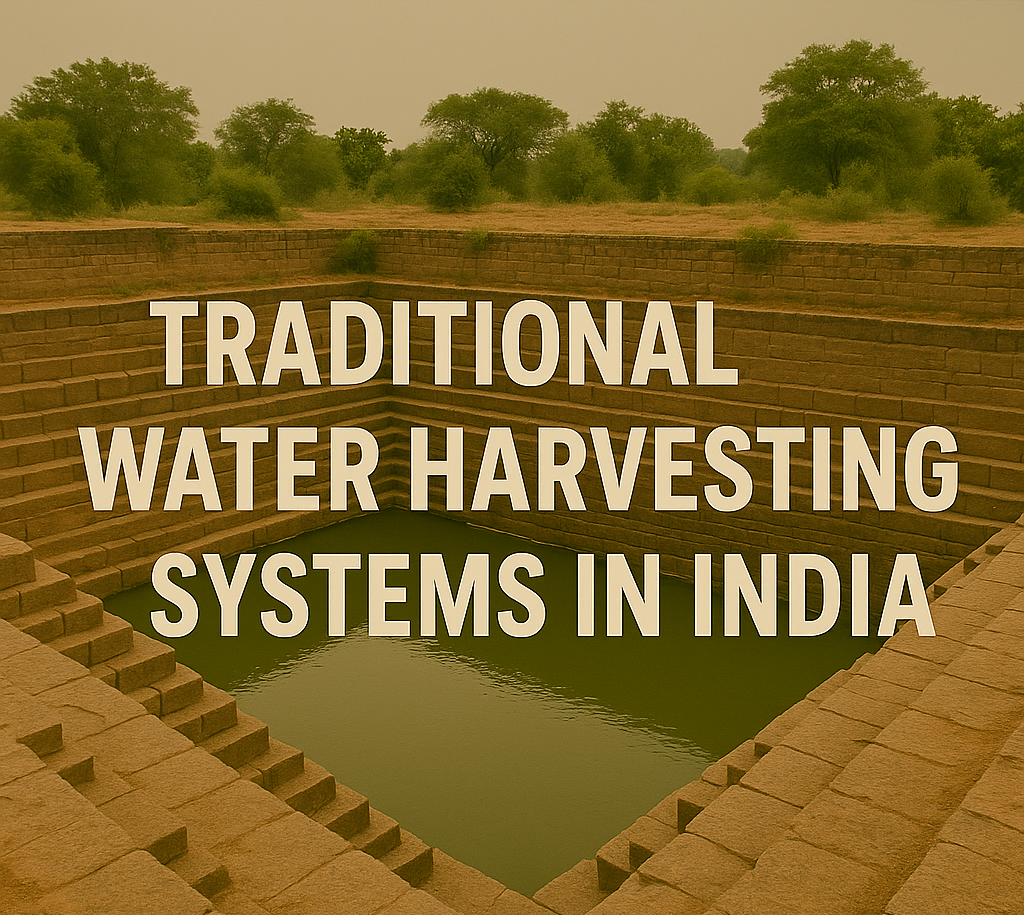Traditional Water Harvesting Systems in India: A Sustainable Solution to Water Scarcity
Introduction
India, despite its vast water resources, is experiencing a severe water crisis.Traditional Water Harvesting Systems in India. The country is facing extreme water stress due to over-extraction of groundwater, water pollution, and the effects of climate change. As of the latest United Nations report, India is one of the 17 countries classified as having extremely high water stress, meaning the country’s water demand far exceeds its supply. With an increasing population and unpredictable weather patterns, it has become crucial to adopt sustainable water management practices. One of the most effective solutions is the water harvesting system, which has been practiced for centuries.
What Are Traditional Water Harvesting Systems in India?
Traditional water harvesting systems refer to methods that were historically developed and used to capture and store rainwater for later use. These systems are designed to harness the monsoon rains, which occur sporadically, and store them to ensure a water supply during the dry seasons. Despite the advances in modern water management systems, these traditional methods continue to play a critical role in water conservation across India.
Key Traditional Water Harvesting Systems in India
1. Step Wells
Step wells, also known as kunds, are iconic structures primarily found in Rajasthan and Gujarat. These wells are built with a series of steps leading down to the water level, which makes it easier to access water even when the groundwater levels drop.
2. Talabs
Talabs are man-made reservoirs or ponds that collect and store rainwater. Found mostly in rural areas, these water bodies have been a primary water source for irrigation, drinking, and livestock.
3. Jhalaras
Jhalaras are step wells that are primarily built along riverbanks and designed to store water during the monsoon season. These water tanks have a filtering system that allows for natural purification before the water is stored.
4. Baolis
Baolis are similar to step wells and are an ancient method found in northern India. These wells often have a staircase that leads down to a reservoir of water. They were historically used for domestic purposes and irrigation.
5. Nadis
Nadis are traditional rainwater harvesting used primarily in South India. These collect water from rainwater and allow it to seep into the ground, recharging the aquifers.
6. Check Dams
Check dams are small dams built across seasonal streams or rivers to store water. This method is commonly used in rural areas to create a barrier that prevents the rapid flow of water, allowing it to accumulate in reservoirs.
The Benefits of Traditional Water Harvesting Systems
1. Sustainable and Eco-Friendly
Traditional water harvesting methods use natural resources and local materials to capture and store rainwater. These systems have minimal environmental impact, requiring less energy and fewer resources to maintain.
2. Groundwater Recharge
Many of these systems, such as check dams, talabs, and nadis, help replenish groundwater tables, ensuring that aquifers remain full even during dry seasons.
3. Cost-Effective
Most traditional water harvesting systems are low-cost to build and maintain, making them an ideal solution for rural areas where modern water infrastructure may not be feasible.
4. Culturally Significant
Traditional water harvesting systems are an integral part of India’s cultural heritage, often intertwined with religious practices and local community life. They have historically been social spaces as well as water sources.
5. Disaster Mitigation
By capturing and storing rainwater, these systems can help prevent flooding, reduce water scarcity during droughts, and manage surface runoff effectively.
The Revival of Traditional Water Harvesting Systems
As India grapples with the challenges of water scarcity, there is a growing interest in reviving these ancient water management practices. Many states, NGOs, and environmental organizations are working to restore these systems, integrate them with modern technologies, and adapt them for current needs.
Government Initiatives
The Indian government has also recognized the importance of traditional water harvesting and is encouraging its revival through various schemes and programs, such as the Jal Shakti Abhiyan and the National Mission for Clean Ganga. These initiatives aim to integrate traditional knowledge with modern solutions to address the water crisis.
Community-Based Approach
Community participation is key to reviving traditional water harvesting systems. By working together to restore ponds, step wells, and other structures, communities can ensure that these systems remain functional and provide long-term water security.
How to Implement Traditional Water Harvesting Systems
If you are interested in incorporating traditional water harvesting methods, here are a few steps you can take:
- Consult Experts: Work with engineers and local water conservation experts who specialize in traditional systems to design and implement solutions.
- Assess Your Needs: Evaluate your water requirements and select a system that suits your area’s climate, topography, and water needs.
- Community Engagement: Collaborate with local communities to restore old water harvesting structures like talabs.
- Integration with Modern Techniques: Blend traditional systems with modern technologies such as rainwater harvesting tanks or filtration systems for cleaner water.
Conclusion:
The need for effective water management has never been more urgent, especially as India faces escalating water scarcity. Traditional water harvesting systems offer a time-tested solution to address this challenge. These systems, which have been used for centuries, provide sustainable methods of collecting, storing, and managing water, ensuring a reliable supply even during dry periods.
At The Ground Water Company, we recognize the value of integrating traditional water harvesting techniques with modern technologies. By promoting the revival of these ancient systems, we aim to ensure water security for future generations.


